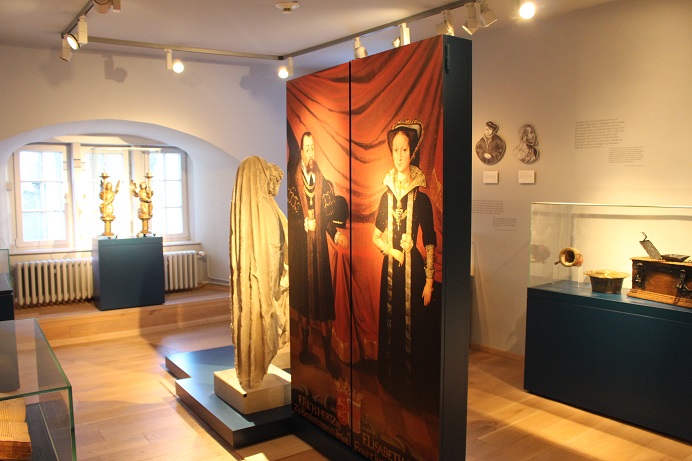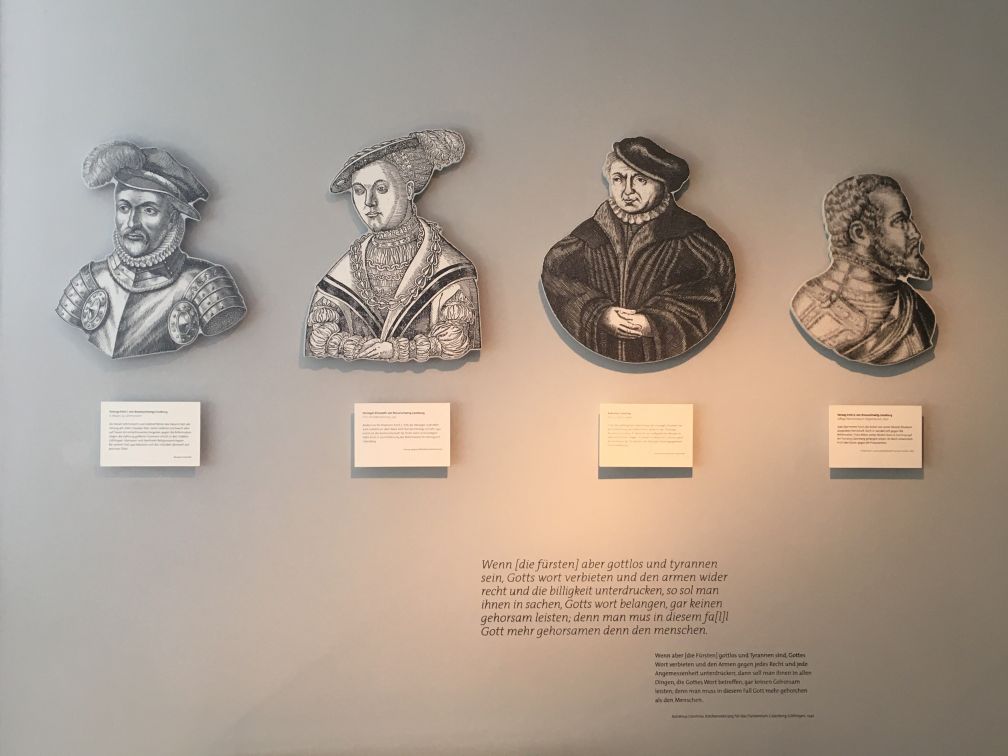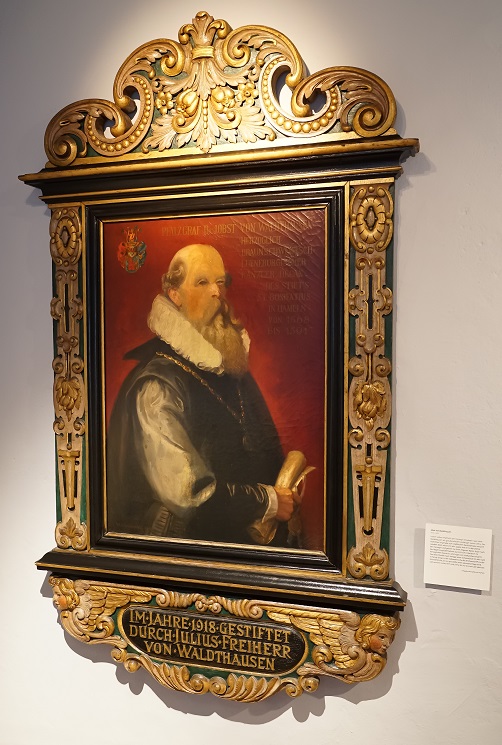
Reformation, © Museum Hameln
Early Modern Period
All the new discoveries and inventions of the time cause people’s World View to change rapidly. The printing press allows for knowledge to be spread at a pace unheard of before; Martin Luther’s new understanding of the faith leads to an existential shift in religious thinking. This results in the formation of two main opposing religious parties. The importance of the religious question lessens only gradually, being replaced by politics, which is now largely determined by the changing power claims of various leaders and rulers. The Age of Enlightenment brings about the call to reason, encouraging people to ask new and rational questions.
Reformation
The One and Only Faith?
Whit Monday, 1538: There is a sudden disturbance at early Mass in the Abbey Church, St. Bonifatius. Some citizen gather at the church, singing songs at the top of their voices, drowning out the Mass. The religious leaders are indignant. A fight ensues and fists fly. What had caused it? A number of years previously, the new teachings of Martin Luther had attracted many followers. They believe that Christ is the only way to God. They have turned away from the Pope and the Old Church. Renewal according to the Word of the Bible is their aim. An increasing number of citizens feel the same way. They want to express this with their singing. The City Council is wary. The local lord, Erich 1st, doesn’t want to upset the emperor and hangs onto the old faith. He dies in 1540 and only then the Council moves to call a Lutheran preacher to Hameln. They are supported in this by the Duchess Elisabeth. In the meantime the abbey remains Catholic. The Reformation only asserts itself fully in 1576.

„Exempelbuch“ and pulpit clocks, © Museum Hameln
Pulpit clocks
Wangelist poorhouse chapel, 18th century
The interpretation of the Divine Word was the focus of the Lutheran church service. However, many a pastor let himself get carried away in religious zeal and preached sermons which were too long. The congregations complained and small pulpit and sermon clocks were introduced. The sand ran for approximately half-an-hour through the clock – which could of course also be turned by the preacher.
Both sand clocks were moved from Wangelist to the museum as a gift from Mrs Quast in 1900.
Exemplified book
Andreas Hondorff, Leipzig, 1573
Each Sunday their beliefs were explained to the congregation for the purposes of consolidation. The pastors worked with illustrative examples and vivid stories taken from exemplified books. Hondorff’s text was very popular in the 16th and 17th centuries. It first appeared in 1568 and then in new editions. In 1575, it was translated into Latin and could thus be understood outside of the German-speaking area.
Hondorff based his book on the 10 Commandments and used the established, traditional examples. He was a theologian and pastor in Droysig and was familiar with the everyday challenges in the community.
Martin Luther
Peter Troschel, mid-17th century
Luther did not plan for disengagement from the Church. He wanted to see a return to belief in the Bible. However, if the Pope rejected the Reformation, it would lead to a rift. The commemorative plaque of St. Michael’s city church in Jena refers to this in a remark attributed to Luther: “In life I was an illness for you, in death I shall become your death, Pope!”
Those who hung up this engraving took a clear position in the debate over the “correct” beliefs.
Walltexts
There are also many among us who have become lazy and complacent, such that they think they can do no wrong […]. The devil devours such souls without them even knowing. God protects and helps us, so that we (as Saint Peter says) may resist him [i.e. the devil] steadfastly through our faith. How shall or can faith remain strong if one devotes oneself not to God’s word without intermission but instead to talking, singing, thinking and other things?
Martin Luther, preface to the Biblical Interpretations of Antonius Corvinus, 1535
Bible
Martin Luther, Wittenberg, 1548
According to Luther, only the Bible could be the guiding principle of belief. He wished to make it accessible for all with his German translation. The New Testament appeared in 1522, the complete edition in 1534. Further editions followed in quick succession due to new book printing processes. The workshop of the “Bible printer” Hans Lufft in Wittenberg especially produced many copies, including this one from 1548.
Baptismal font
Hamelin Cathedral, 1700
Baptism consists of a commitment and declaration: God accepts the person to be baptised into his eternal communion; the baptised person – represented by the parents and godparents – acknowledges God. The water taken from the font which is poured over the head of the person being baptised and the Word of the Bible are indications of this “sacred act”, one of the great sacraments.
The engraved picture of Boniface refers to the origin of the font in the collegiate church. It was bought by the museum for 30 marks in 1924.

Duke Erich I of Brunswick-Lüneburg and his wife Elisabeth, © Museum Hameln
Duke Erich I of Brunswick-Lüneburg and his wife Elisabeth of Brandenburg
N.N., around 1625
The painting shows the couple side-by-side almost coequally. In fact the significantly younger Elisabeth knew how to assert herself as a wife. She forced the Duke to end his relationship with his lover by making witchcraft allegations against her competitor. Later she used the death of the Duke and the minority of her son to transfer governmental power to herself.
Stockholm National Museum

Anna Rumschottel, a witch?, © Museum Hameln
Summons for the arrest of Anna Rumschottel for witchcraft
Duke Erich I, open letter, 3rd May 1534
Anna Rumschottel was the lover of the Duke before his marriage to Elisabeth. Erich maintained the relationship during his marriage. The young Duchess Elisabeth did not only feel neglected. Considering the advanced age of her husband, she must have feared for her own security and the future of her still underage son.
She created political scope by the accusation of witchcraft against Anna Rumschottel: to save his own reputation, the Duke had to proceed against his own lover.
Lower Saxony State Archive – Hannover Main State Archive
We, Erich the Elder, by God’s grace the Duke of Brunswick and Lüneburg […] profess and declare to everyone [herewith] with this open letter that due to diverse mistreatment and troubling acts and witchcraft of a [person] named Anna Rumschottel against the highborn Princess Elisabeth, born Margravine of Brandenburg […], Duchess of Brunswick and Lüneburg, our most beloved wife – insofar as such damage [has been] caused to her dear body and health three times by fiendish witchcraft that she has only partially recovered her physical health through divine help and mercy after a long struggle with death -, to seek the highest justice for our aforementioned most beloved wife, we are beset and intend to demand and implement the following. […] We command […] for our sake and name all courts and authorities that the same Anna Rumschottel shall be searched for and interrogated, reported, arrested and scrupulously questioned on account of her disgraceful actions […].
Summons for the arrest of an alleged witch from Hamelin
Duke Erich I, command to the Hamelin city council, 26th January 1532
Anna Rumschottel is advertised as wanted for witchcraft across the whole country. Probably not by coincidence she flees successfully to the neighbouring diocese of Minden. Some women accused of being her assistants are however tried in Hamelin for witchcraft. Duchess Elisabeth has been troubled by the escape of Anna Rumschottel for quite some time. She manages to resolve the conflict politically in her favour: To placate his wife, Duke Erich entrusts her in 1535 with the dominion of Münden.
Hamelin City Archive

Angel candlesticks, © Museum Hameln
Angel candlesticks
Hamelin market church, 1536
The angel candlesticks were commissioned by Cardinal Albrecht of Brandenburg. Albrecht, as the archbishop in Mainz and Magdeburg, was an antagonist of Luther. Humanistically educated and musically disposed, he supported many contemporary artists. He had connections to Cranach, Grunewald, Dürer and the world-famous Vischer workshops in Nuremberg. The candlesticks were cast here under Albrecht’s instructions.
The route of the valuable items from Nuremberg to Hamelin is completely unknown. Were the candlesticks placed in the market church before the beginning of the Reformation? In their statement and design they are a clear affirmation of Catholic faith.
Item on loan: Luth. Prot. Parish of St. Nicolai, Hamelin

Duke Erich I, Duchess Elisabeth, Anton Corvinus and Duke Erich II, © Museum Hameln
Duke Erich I of Brunswick-Lüneburg
A. Mayer, 19th century
As a loyal vassal and mercenary of the Emperor, the Duke held fast to the old beliefs. However, his permanent lack of money made decisive resistance to the Reformation difficult. He granted the cities of Göttingen, Hannover and Northeim religious privileges in return for the payment of large sums. At the time of his death in 1540, the debts however amounted to 900,000 thalers.
Duchess Elisabeth of Brunswick-Lüneburg
N.N., ecclesiastical order, 1542
The Duchess, in contrast to her husband Erich I, openly converted to Lutheranism in 1538. After the Duke’s death in 1540, she used the guardianship of her still minor son Erich II to introduce the Reformation in the Duchy of Calenberg.
Herzog August Library, Wolfenbüttel
Antonius Corvinus
N.N., 17th century
One of the most important supporters of the Duchess Elisabeth in the introduction of Lutheran teachings was the theologian Antonius Corvinus. He served her as an authoritative advisor in all church affairs. In this function, Corvinus was also the author of the church constitution issued in the name of the Duchess.
Hannover History Museum
Duke Erich II of Brunswick-Lüneburg
Sylloge Numismatum Elegantiorum, 1620
In 1546, Erich began his reign, which was previously performed by his mother Elisabeth. However, he turned against the Reformation. Despite his mother’s requests, he left Corvinus sitting imprisoned in Calenberg Castle. Erich supported the Emperor in the kingdom against the Protestants.
Saxony-Anhalt University and State Library, Halle
Out of loyal duty, I may not withhold from your royal grace that on Monday and Tuesday during Pentecost quite a few people gathered here in Hamelin at approximately six to seven o’clock during early mass. When the preacher then began to preach, [they] sang the Martinian song in the church. I forbade them, referring to your royal grace, which they totally flouted […].
Vogt Otto Schrader, report to Duke Erich I, 1538
If [the princes] are however godless and tyrants, if they prohibit the Word of God and oppress the poor against all law and propriety, then one should be disobedient in all things concerning God’s Word; since one must in this case obey God more than people.
Antonius Corvinus, ecclesiastical order for the Principality of Calenberg-Göttingen, 1542
Ecclesiastical order
Duke Julius of Brunswick-Lüneburg, Helmstedt, 1615
The sovereigns of principalities in Germany which had become Lutheran also called for the religious leadership of their subjects. They issued church constitutions in which the content of beliefs and practical church organisation were prescribed.
Many cities strived for independence in ecclesiastical matters and published their own regulations – not so in Hamelin.

Objects for donation, © Museum Hameln
Collection bag
Hamelin market church, 18th century
In 1899, various objects from the market church were left to the museum, where they were restored and refurbished. The collection bag was among them.
Collection box
Hamelin, around 1780
The giving of donations at church on Sundays is a matter of course. How much is donated is supposed to remain unknown to fellow members of the congregation. It can be heard, of course, whether a coin has fallen into a metal box and how dull the clink is, i.e. how heavy it is.
A Roman coin is displayed at this exhibition which was found in 1934 in a collection box of the congregation in Börry. A farmer took the opportunity to hand in an old coin no longer in currency – and made a more interesting donation to the museum than he perhaps realised.
Offertory box
Wangelist poorhouse chapel, 18th century
The box, purchased in 1973, is thought to have come from the chapel in Wangelist. Both the locks are sawn off. Presumably the offertory box has been long neglected before being passed on. Perhaps there was still money in it and the key was missing? Or was the box handed over after being broken into during a theft?

Jobst von Waldthausen, © Museum Hameln
Jobst von Waldthausen
N.N., 1918
Luther himself recommended Jobst Waldthausen to the Duchess Elisabeth in 1540 as a faithful supporter of his teachings. The citizen of Hamelin had just been appointed city legal advisor. Only a year later, he entered the service of the Duchess and became one of her closest advisors. In addition, he remained in the service of the Duchy after Erich II became the ruler: He was made Vice Chancellor in 1546.
The picture was made after presentation of a medallion in 1918. It hung for a long time in the south-west niche of the nave of the Cathedral, where it fell victim to an acid attack in 1977. It was restored in 1983 and until recently decorated the vestry.
Item on loan: Hamelin Münsterkirche
Small offerings and salvation
According to pre-Reformation religious beliefs, the believer could move closer to obtaining salvation by giving to charity. For Luther, however, unconditional belief was the prerequisite for the forgiveness of God. The “small offering” thus took on a different character. Spontaneous “good deeds” were replaced by the regular collection of donations during or after the church service.
Exact records were kept of the revenue. The proceeds were used specifically for community purposes or social welfare facilities.
[From the pulpit one must now] preach at least the text of the gospel and [Apostles’] letters clearly and plainly, so that the idolatry introduced into the Church by the Papacy is daily more and more driven out, which means nothing less than that every day we will see many devils driven out through the Spirit of God […].
Martin Luther, preface to the Bible Interpretations of Antonius Corvinus, 1539

Pulpit door from the Münsterkirche, © Museum Hameln
Pulpit door
Münsterkirche (Hamelin Cathedral), 1619
Interpretation of the holy scriptures in the sermon was at the heart of the new Lutheran church service. The pulpit thus had special significance: the pastor spoke to the congregation from this elevated place.
The pulpit door of the Cathedral was intricately designed, and it was even mentioned by Herr in 1765. Both Luther and Melanchthon can be seen, the two most important representatives of the Lutheran Reformation. Below them, three men stand in front of a tree. On the right could be Moses with the tablet of commandments, in the centre Christ and on the left probably John the Baptist.
The Cathedral pulpit is visually striking due to its carving work and fine painting.
Johann Daniel Gottlieb Herr, Collectanea, around 1760

Mary and John, © Museum Hameln
Mary and John
around 1525
Both figures belong to a cathedral churchyard crucifixion group made in the Weser region at the beginning of the 16th century.
In many German cities – above all in the southern German region – the introduction of the Reformation was accompanied by a wave of destruction of sculptures belonging to the old faith. In Hamelin, it was different! Here it did not come to iconoclasm as in most other cities in northern Germany. Figures from the time before the Reformation simply remain standing for the most part.
The crucifix was repaired in 1693 and a collection box was added in 1751. The French soldiers, who were Catholic believers, are said to have often kneeled here to pray during the occupation from 1757.
